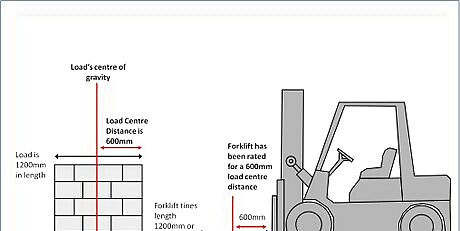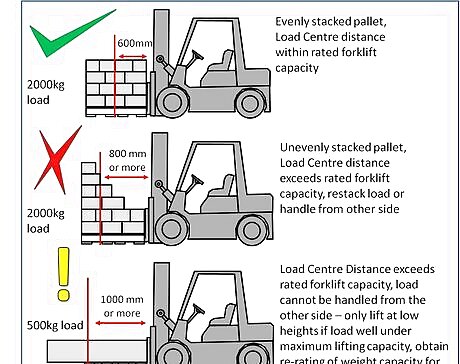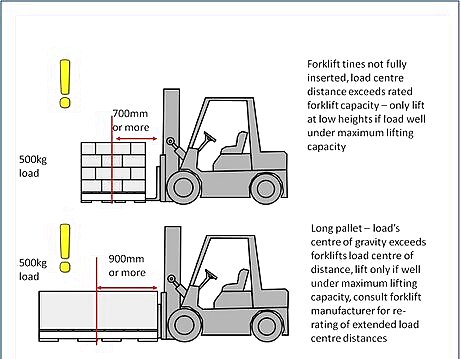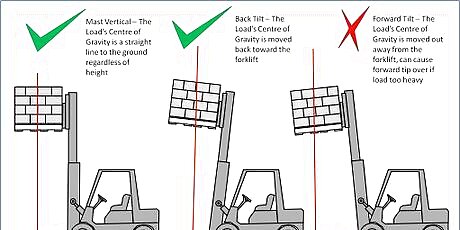
views
Know how to find out your forklift's load center distance. All forklifts are rated by the manufacturer to a maximum weight capacity at a certain height and load center distance. All this information can be found on the Forklift's Data Plate. An example of how a data plate would read: Load Center Distance: 600mm Mast Vertical 2000kg Forward tilt 1000kg Height A: 5000mm. Therefore, from this information, the maximum weight the forklift can carry is 2000kg to a height of 5000mm, as long as the mast is vertical, or back tilt is applied.The load should have a maximum length of 1200mm (to make the load center distance 600mm)

Learn how to calculate load center distance of loads. In most cases, the load center of an evenly stacked pallet/"load" will be in the center of the load - using this information, if a load is 1200mm in length, then its load center will be at 600mm - correct for our forklift's load center distance rating. However a load on a pallet 1400mm in length will have a load center distance of 700mm which exceeds our forklift's rated load center distance - this load can only be picked up if is well under the maximum rated weight capacity of the forklift - some forklifts are rated for multiple load center distances, however, others may not be.Load cent.jpg

Consider unevenly stacked and irregular loads. These types of factors majorly affect load center distance, even if the load is 1200mm in length, if all the weight is stacked away opposite the forklift, then the load center distance of the load will be increased outwards, however a simple remedy is to simply pick up the pallet from the other side if possible, or re-stack - with standard loads such as boxes on a standard pallet it will be possible. However, for irregular loads such as machinery overhang on a pallet, it may not be possible - simply ensure it is well under the weight capacity and handle with care.

Understand the effects of Long Pallets or Forklift tines not fully inserted. Two other common factors that can affect load center distance are the use of longer or irregularly sized pallets, or simply not inserting the forklift's tines all the way into a pallet before lifting. Both are sometimes unavoidable in forklift operations where different pallets are handled, or trucks are loaded, so both have to be managed by ensuring the loads stay well within the forklifts maximum rated capacity. If the forklift is constantly having to handle loads exceeding its load center distance, however, it will have to be re-rated by the manufacturer or an authorized forklift specialist to determine its maximum safe lifting capacity at extended load center distances.Long not in fork lcd 4.jpg

Learn how tilt affects load center distance. A major factor often overlooked by newer and experienced forklift operators alike is the use of tilt and its ability to affect the forklift's load center distance. As previously mentioned on the forklift's data plate, the weight capacity of the forklift is halved when the forward tilt is used. This is because, while at ground level and low lifting levels, the use of tilt may indeed be negligible to affect the load center distance of the load, at height, tilt can greatly affect the load center distance, particularly forward tilt. By moving the load forward and away from the forklift, the load's center of gravity is now well beyond the recommended load center distance, so even when loads are within the forklifts maximum lifting capacity, forward tilt reduces the lifting capacity, and is the main factor in forward-forklift tip-overs, as operators are simply unaware of it. Back tilt on the other hand, reduces the load center distance (which is good for added stability). However it is usually not recommended to handle loads at full back tilt at high heights, since the load will need to be returned to mast vertical (level forks) before stacking, at height, moving the load at height with tilt can cause tip-overs or dropped loads if moved too quickly.Tilt and load cent.jpg
Consider the use of attachments. All forklift attachments need to be approved for use by the manufacturer and/or a forklift specialist before use - this includes the re-rating of the forklift's lifting capacity when using different attachments due to the differing load centers among other factors. Some common forklift attachments that have a significant effect on the forklift's load center distance/lifting capacity include drum lifters (beak and claw or clamp) fork tine extensions ("slippers), carpet spikes and many more.













Comments
0 comment